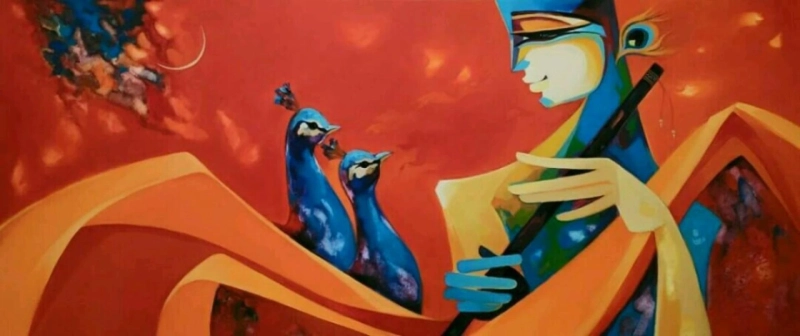Art has long served as a medium for spiritual expression, with religious paintings offering a profound connection between the divine and the observer. Among these, paintings of Lord Krishna hold a special place, capturing the multifaceted persona of the beloved deity—from his playful childhood as Bal Gopal to his profound wisdom as the charioteer in the Bhagavad Gita. These paintings not only depict Krishna’s divine attributes but also serve as a source of inspiration, devotion, and aesthetic pleasure for collectors and art enthusiasts alike.
The artistic representation of Lord Krishna has evolved over centuries, incorporating diverse styles such as Pichwai, Madhubani, and Tanjore paintings, each offering a unique perspective on his life and teachings. This article explores the rich tradition of Krishna paintings, their significance in religious art, actionable insights for artists, and how collectors can appreciate and invest in these timeless masterpieces.
The Symbolism and Spiritual Significance of Krishna Paintings
Lord Krishna, revered as the eighth incarnation of Vishnu, embodies love, wisdom, and cosmic playfulness. His depictions in paintings often carry deep spiritual symbolism:
- The Flute and Peacock Feather – The flute represents the soul’s longing for divine connection, while the peacock feather symbolizes purity and transcendence.
- Raas Leela – Paintings depicting Krishna’s dance with the Gopis illustrate the divine play of love and devotion.
- Krishna as the Charioteer – The iconic Mahabharata scene, where Krishna imparts the Bhagavad Gita’s teachings to Arjuna, symbolizes guidance and righteousness.
- Bal Gopal – Krishna’s childhood images, often shown stealing butter or playing mischievously, symbolize divine innocence and joy.
These elements make Lord Krishna paintings more than just visual art—they are an expression of spiritual philosophy and devotion.
Artistic Styles and Techniques in Krishna Paintings
Different Indian art forms have represented Lord Krishna uniquely, preserving cultural and regional traditions:
- Pichwai Paintings – Originating from Rajasthan, these intricate paintings depict scenes of Krishna’s life, particularly associated with the Nathdwara temple. Characterized by rich colors and detailed ornamentation, Pichwai art is highly sought after by collectors.
- Tanjore Paintings – This South Indian style is known for its use of gold leaf, semi-precious stones, and relief work, portraying Krishna in opulent and divine settings.
- Madhubani Paintings – A folk art style from Bihar, Madhubani Krishna paintings use vibrant colors and intricate patterns, emphasizing narrative storytelling.
- Miniature Paintings – Inspired by Mughal and Rajasthani art, these delicate paintings capture Krishna’s various exploits in fine detail and exquisite brushwork.
- Modern and Abstract Krishna Art – Contemporary artists have reinterpreted Krishna’s imagery with modern techniques, blending traditional symbolism with abstract and experimental approaches.
Actionable Advice for Artists Creating Krishna Paintings
If you are an artist inspired to create Krishna-themed paintings, consider the following key points:
- Understand the Spiritual Context – Krishna’s imagery is deeply tied to mythology and devotion. Studying scriptures like the Bhagavad Gita and Srimad Bhagavatam can provide valuable insights into his divine persona.
- Master Traditional Techniques – Learning classic styles such as Pichwai or Tanjore painting can help preserve authenticity while allowing for creative innovations.
- Incorporate Symbolism Thoughtfully – Every element in Krishna paintings—lotuses, cows, the Yamuna River—carries deeper meaning. Thoughtful integration of these symbols enhances the spiritual impact.
- Experiment with Modern Interpretations – While traditional styles have immense value, adding contemporary elements can attract a wider audience and keep the art form relevant.
- Ensure High-Quality Materials – Using high-grade colors, gold leaf (if applicable), and quality canvas or paper ensures durability and enhances the artwork’s visual appeal.
Collecting and Preserving Krishna Paintings
For collectors and art enthusiasts, Krishna paintings offer not only aesthetic beauty but also cultural and spiritual enrichment. Here are key factors to consider:
- Authenticity and Provenance – Verify the artist’s credentials, especially when purchasing traditional styles like Pichwai or Tanjore. Buying from reputable galleries ensures authenticity.
- Material Quality and Longevity – Paintings with gold leaf embellishments and natural pigments require proper care. Ensure that the materials used are of archival quality.
- Display and Preservation – Keep paintings away from direct sunlight and excessive moisture to maintain their vibrancy over time. Framing with UV-protective glass is recommended.
- Investment Potential – Krishna paintings, particularly those by renowned artists, hold significant value in the art market. Research the artist’s reputation and the historical significance of the style before investing.
The Future of Krishna Art in a Digital Age
With advancements in technology, Krishna paintings are finding new expressions in digital and NFT art. Artists are now leveraging AI-generated designs and digital brushwork to create innovative representations of Lord Krishna. Online art marketplaces have also made it easier for global audiences to access and appreciate these spiritual masterpieces.
The fusion of tradition and technology ensures that Krishna paintings continue to inspire future generations while retaining their cultural essence. Collectors can now explore limited-edition digital Krishna artworks, bridging the gap between ancient mythology and modern aesthetics.
Conclusion
Lord Krishna paintings transcend mere artistic expression, offering a profound spiritual journey through colors, symbolism, and divine imagery. Whether you are an artist seeking to depict Krishna’s divinity, a collector looking to invest in traditional art, or a devotee drawn to his enchanting presence, these paintings hold immense cultural and spiritual significance.
As the art world continues to evolve, Krishna’s timeless charm remains ever relevant, inspiring both traditional artisans and modern creators. Engaging with Krishna paintings is not just about admiration—it’s an opportunity to connect with the essence of divinity, creativity, and devotion.
For those passionate about religious paintings, exploring the world of Krishna art is a fulfilling experience that bridges history, faith, and artistic excellence. Whether through traditional Pichwai masterpieces or contemporary interpretations, the legacy of Krishna in art continues to captivate hearts across generations.


